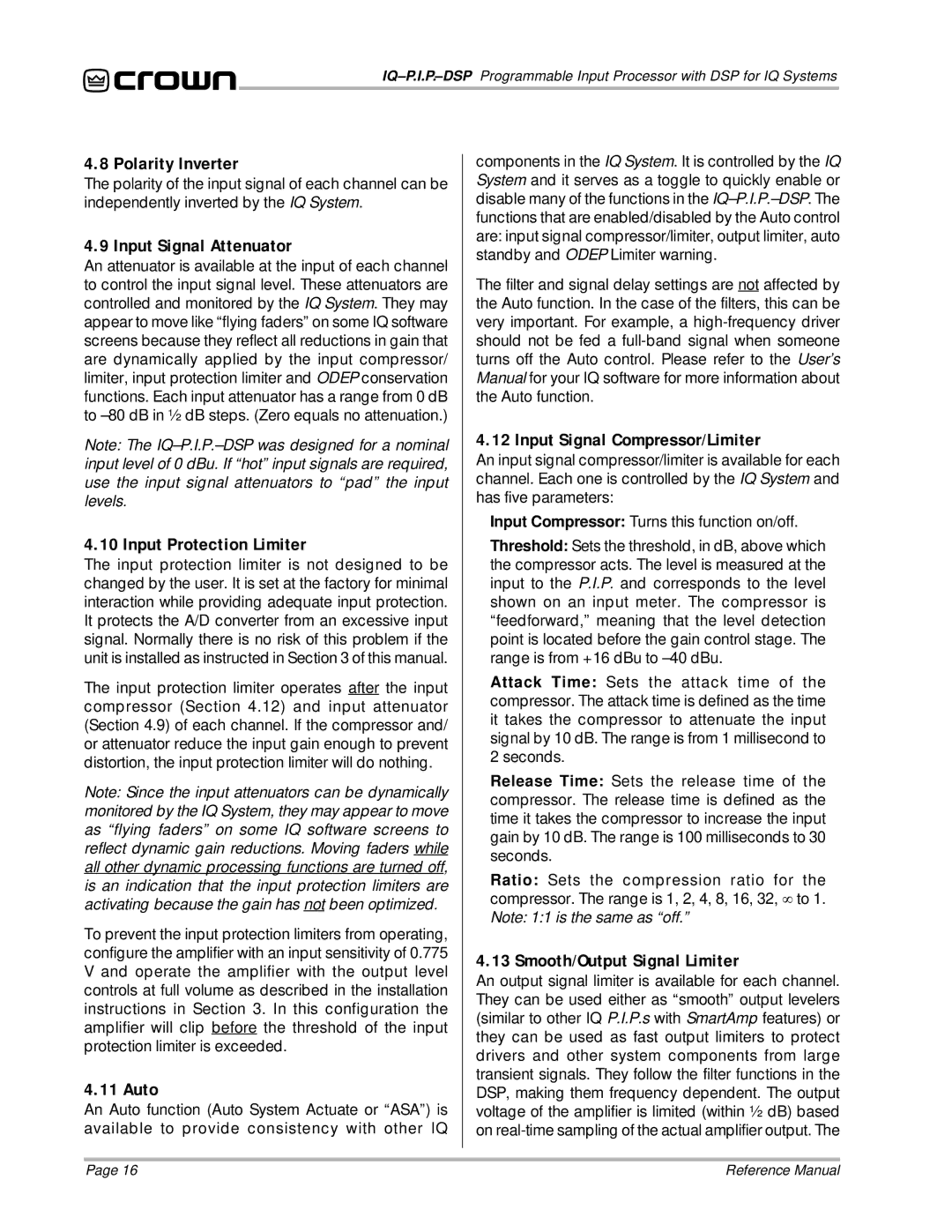
4.8 Polarity Inverter
The polarity of the input signal of each channel can be independently inverted by the IQ System.
4.9 Input Signal Attenuator
An attenuator is available at the input of each channel to control the input signal level. These attenuators are controlled and monitored by the IQ System. They may appear to move like “flying faders” on some IQ software screens because they reflect all reductions in gain that are dynamically applied by the input compressor/ limiter, input protection limiter and ODEP conservation functions. Each input attenuator has a range from 0 dB to
Note: The
4.10 Input Protection Limiter
The input protection limiter is not designed to be changed by the user. It is set at the factory for minimal interaction while providing adequate input protection. It protects the A/D converter from an excessive input signal. Normally there is no risk of this problem if the unit is installed as instructed in Section 3 of this manual.
The input protection limiter operates after the input compressor (Section 4.12) and input attenuator (Section 4.9) of each channel. If the compressor and/ or attenuator reduce the input gain enough to prevent distortion, the input protection limiter will do nothing.
Note: Since the input attenuators can be dynamically monitored by the IQ System, they may appear to move as “flying faders” on some IQ software screens to reflect dynamic gain reductions. Moving faders while all other dynamic processing functions are turned off, is an indication that the input protection limiters are activating because the gain has not been optimized.
To prevent the input protection limiters from operating, configure the amplifier with an input sensitivity of 0.775 V and operate the amplifier with the output level controls at full volume as described in the installation instructions in Section 3. In this configuration the amplifier will clip before the threshold of the input protection limiter is exceeded.
4.11 Auto
An Auto function (Auto System Actuate or “ASA”) is available to provide consistency with other IQ
components in the IQ System. It is controlled by the IQ System and it serves as a toggle to quickly enable or disable many of the functions in the
The filter and signal delay settings are not affected by the Auto function. In the case of the filters, this can be very important. For example, a
4.12 Input Signal Compressor/Limiter
An input signal compressor/limiter is available for each channel. Each one is controlled by the IQ System and has five parameters:
Input Compressor: Turns this function on/off.
Threshold: Sets the threshold, in dB, above which the compressor acts. The level is measured at the input to the P.I.P. and corresponds to the level shown on an input meter. The compressor is “feedforward,” meaning that the level detection point is located before the gain control stage. The range is from +16 dBu to
Attack Time: Sets the attack time of the compressor. The attack time is defined as the time it takes the compressor to attenuate the input signal by 10 dB. The range is from 1 millisecond to 2 seconds.
Release Time: Sets the release time of the compressor. The release time is defined as the time it takes the compressor to increase the input gain by 10 dB. The range is 100 milliseconds to 30 seconds.
Ratio: Sets the compression ratio for the compressor. The range is 1, 2, 4, 8, 16, 32, ¥ to 1. Note: 1:1 is the same as “off.”
4.13 Smooth/Output Signal Limiter
An output signal limiter is available for each channel. They can be used either as “smooth” output levelers (similar to other IQ P.I.P.s with SmartAmp features) or they can be used as fast output limiters to protect drivers and other system components from large transient signals. They follow the filter functions in the DSP, making them frequency dependent. The output voltage of the amplifier is limited (within ½ dB) based on
Page 16 | Reference Manual |
